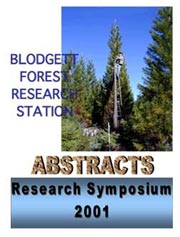ABSTRACT 16
Pruning to Reduce Blister Rust Incidence
in Sugar Pine
Kevin L. O'Hara, Tudor Stancioiu, Mark Spencer, and Rolf Gersonde
|
|
|
Pruning of lower limbs of eastern white pine and western white pine has been an effective treatment for reducing white pine blister rust (Cronartium ribicola) infections. By removing limbs and therefore foliage, infection sites are removed, and resultant infections are substantially reduced. It is assumed that infections are more common near the ground because of higher humidity and the requirement of high humidity for spore infection in needle fascicles. No results have been reported for pruning sugar pine to reduce white pine blister rust infection.
During the summer of 2000, sugar pine trees were pruned at two study areas in California. At Blodgett trees were pruned in 7 different compartments. Two stands on Roseburg Forest Products lands near Lake Almanor were also pruned. At both study areas, trees between approximately 8 and 20 feet (2.4 - 6.1 m) tall were selected. Sample trees were required to show no visible effects of blister rust, and to be free of any other damage (animal, logging, etc.). Every alternate tree that met the sampling requirements was pruned to half its total height, but never more than 8 feet (2.4 m). Loppers were used to remove all living and dead branches to the pruning height. All needle fascicles below the pruning height were also removed. Alternate trees were unpruned. All trees were tagged and measured for height, diameter, height to base of live crown or pruning height, and branch whorls above breast height were counted to determine breast height age.
At Blodgett, the total tree sample included 127 trees: half of which were pruned. At Lake Almanor, 156 trees were sampled: half were pruned. Our future plans with this study are to monitor sample trees for mortality effect on an annual basis. At present, we plan to complete a remeasurement in 2005 to determine growth effects of pruning and document pruning effects on blister rust mortality. This timeline may be accelerated if mortality or infection rates appear to differ between pruned and unpruned trees in our monitoring.
|
Contact Author: Kevin L. O'Hara, Department of Environmental Science, Policy & Management, 207 Mulford Hall, University of California, Berkeley, Berkeley, CA 94720-3114, (510) 642-2127, e-mail: ohara@nature.berkeley.edu
|
|
|

